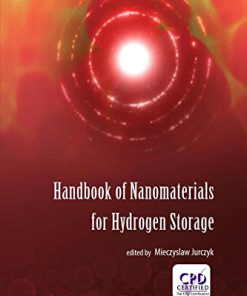Physico chemical properties of nanomaterials 1st Edition by Vladimir Murashov, Richard Pleus 1351168588 9781351168588
$50.00 Original price was: $50.00.$25.00Current price is: $25.00.
Physico chemical properties of nanomaterials 1st Edition by Vladimir Murashov, Richard C. Pleus – Ebook PDF Instant Download/DeliveryISBN: 1351168588, 9781351168588
Full download Physico chemical properties of nanomaterials 1st Edition after payment.

Product details:
ISBN-10 : 1351168588
ISBN-13 : 9781351168588
Author: Vladimir Murashov, Richard C. Pleus
Throughout human history, we have long encountered the combination of promise, risk, and uncertainty that accompanies emerging technologies. Nanotechnology is a recent example of an emerging technology that promises to drastically improve existing products as well as allow for creative development of new goods and services. This new technology also has its potential downsides. Industry, academia, and regulatory agencies are all working overtime to assess risks accurately while keeping up with the pace of development. Subtle changes in the physicochemical properties of engineered nanomaterials (ENMs) can influence their toxicity and behavior in the environment and so can be used to help control potential ENM risks. This book attempts to encompass the state of the science regarding physicochemical characterization of ENMs. It illuminates the effort to understand these properties and how they may be used to ensure safe ENM deployment in existing or future materials and products.
Physico chemical properties of nanomaterials 1st Table of contents:
1. Introduction
2. How Physical and Chemical Information Predicts the Action of Molecules: A Historical Overview
2.1 A Definition for Pharmacology and Toxicology
2.2 Entities Do Not Act Unless Attached
2.3 The Language of Chemical Attachment
2.3.1 Principles and Equations that Define Attachment Quantitatively
2.3.2 Graphical Display and Analysis of Receptor Binding Interactions
2.4 Types of Drugs and Their Actions
2.4.1 Attachment Is Not Always Reversible
2.4.2 The Chemical Basis of Attachments
2.4.3 Other Attachments in Pharmacology and Physiology
2.4.3.1 Attachment to enzymes
2.4.3.2 Attachment to channels and transporters
2.4.3.3 Attachment to antibodies
2.4.3.4 Attachment to nucleic acids
2.4.3.5 Attachment via chelation
2.4.4 Diverse Receptors for Toxic Agents
2.4.4.1 Toxins that attach to receptors
2.4.4.2 Toxins that attach to enzymes
2.4.4.3 Toxins that attach to ion channels or transporters
2.4.4.4 Toxins that attach to DNA
2.4.4.5 Toxins that generate attachments
2.4.4.6 Metal ion attachment, chelation, and toxicity
2.4.5 What about Attachment in the Case of Particle Toxicity?
3. Physicochemical Characterization: From Molecules to Particles
3.1 Introduction
3.2 Origins of Physicochemical Properties
3.3 Intermolecular Interactions
3.3.1 Quantum-Mechanical Interactions
3.3.2 Electrostatic Interactions
3.3.2.1 Charge-charge interactions
3.3.2.2 Charge-dipole interactions
3.3.2.3 Dipole-dipole interactions (Keesom interactions)
3.3.3 Polarization Interactions
3.3.3.1 Ion-induced dipole interactions
3.3.3.2 Dipole-induced dipole interactions (Debye interactions)
3.3.3.3 Induced dipole-induced dipole interactions (London interactions)
3.3.4 Complex Molecular Systems
3.4 Particle-Molecule Interactions
3.4.1 Interactions Governing the Physical Adsorption of Molecules to Particle Surfaces
3.4.2 Interactions Governing Particle Surface Wettability
3.5 Particle-Particle Interactions
3.5.1 Van der Waals Interactions
3.5.2 Macroscopic Continuum Approach to van der Waals Attraction
3.5.3 Electrostatic Interactions
3.5.4 Coulombic/Static Electric Effects
3.5.5 Ion Electrostatics
3.5.6 Hydrophobic (Solvation) Interactions
3.5.7 Hydration (Solvation) Interactions
3.5.8 Steric Interactions
3.6 Collective and Complex Interparticle Interactions
3.6.1 The Particle Peclet Number
3.7 Principles of Physicochemical Characterization
3.8 Interactions, Dependencies, and Hierarchy
3.9 Characterizing for Purpose and Not for Endpoint: The Fit-for-Purpose Criterion
3.10 Reporting
3.11 Standard Methods and Reference Materials
3.12 Physicochemical Characterization: From Molecules to Particles
3.13 Review of Select Physicochemical Properties: Molecules
3.13.1 Flammability, Corrosivity, and Oxidizing Ability
3.13.2 Molecular Weight
3.13.3 Boiling Point
3.13.4 Vapor Pressure
3.13.5 Henry’s Law Constant
3.13.6 Water Solubility
3.13.7 Octanol-Water Partition Coefficient
3.13.8 Acidity (pKa)/Ionization State
3.13.9 Soil/Sediment Adsorption Coefficient
3.13.10 Hydrogen Bonding
3.13.11 AE Energy [HOMO-LUMO]: Reactivity
3.14 Review of Select Physicochemical Properties: Particles
3.14.1 Dustiness
3.14.2 Dissolution Rate
3.14.3 Characteristic Primary Particle Size Distribution
3.14.4 Dispersible Particle Size Distribution
3.14.5 Characteristic Particle Shape
3.14.6 Density
3.14.7 Surface pKa, Surface Charge, and Isoelectric Point
3.14.8 Specific Surface Area
3.14.9 Wetting Behavior
3.14.10 Deposition, Heteroagglomeration, and Homoagglomeration Potential
3.14.11 Surface Reactivity
3.15 Purpose for Physicochemical Characterization
3.15.1 Estimating Inhalation Exposure
3.15.2 Estimating Concentration in Water
3.15.3 Estimating Migration through Soil into Groundwater
3.15.4 Estimating Removal from Wastewater Treatment
3.15.5 Estimate Absorption through the Skin, Eyes, Lungs, and the GI Tract
3.15.6 Estimating Aquatic Toxicity
3.15.7 Estimate Bioaccumulation, Biomagnification, and Persistence
3.16 Considerations and Challenges for Nanoscale Particulate Chemical Substances
3.17 Summary
4. Common Physicochemical Properties
4.1 Introduction
4.2 Promulgated Lists
4.2.1 The United States/Canada
4.2.2 Europe
4.2.3 Australia
4.2.4 Other Countries
4.2.5 International Organizations
4.3 Specific Physicochemical Parameters
4.3.1 Size, Shape, and Dimensional Characteristics
4.3.1.1 External dimensional characteristics
4.3.1.2 Surface area and internal dimensions
4.3.2 Chemical Identity and Properties
4.3.3 Surface Chemistry
4.3.4 Advanced and Application-Specific Characteristics
4.3.4.1 Reactivity
4.3.4.2 Suspension stability
4.3.4.3 Bulk powder properties
4.3.4.4 Protein corona
4.3.4.5 Composite materials
4.3.4.6 Other properties
4.4 Summary and Conclusions
5. Physicochemical Properties of Engineered Nanomaterials and Their Importance in Assessing Relevant Metrics of Inhalation Exposures in Occupational Settings
5.1 Introduction
5.2 Commonly Measured Airborne Particle Properties in Occupational Settings
5.2.1 ENM Physicochemical Properties Important for Occupational Inhalation Exposures
5.2.2 Exposure Monitoring
5.2.2.1 Real-time instruments
5.2.2.2 Time-integrated sampling
5.2.3 Summary of Occupational Exposure Literature
5.3 Comparison of ENM Metrics of Workplace Exposure to Toxicological Metrics of Response
5.3.1 Biological Relevance of Workplace Exposure Measurements
5.3.1.1 Size/size distribution/ morphology
5.3.1.2 Surface area
5.3.1.3 Bulk/surface chemistry
5.3.1.4 Crystallinity
5.3.2 Carbon Fibers and Nanotubes
5.3.2.1 Toxicological endpoints for occupational exposure limits
5.3.2.2 Relevant exposure metrics for carbon nanofibers/ nanotubes
5.3.2.3 Occupational exposure assessment and laboratory toxicology
5.3.3 Titanium Dioxide
5.3.3.1 Toxicological endpoints for occupational exposure limits
5.3.3.2 Relevant exposure metrics for ultrafine TiO2
5.3.3.3 Occupational exposure assessment and laboratory toxicology
5.4 Summary
6. Physicochemical Properties and Their Importance in the Environment: Current Trends in Nanomaterial Exposure
6.1 Introduction
6.2 The State of Science in Nanomaterial Exposure
6.2.1 Nanoparticle Nomenclature
6.2.2 Nanomaterial Manufacturing
6.2.3 Nanomaterial Release from Industry
6.2.4 Natural Sources of Nanomaterials
6.2.4.1 The methods and data available for releases from products across the life cycle
6.2.5 The Diversity of Nanotechnology Products
6.2.6 Transformations of ENMs Have an Impact on Exposures
6.2.6.1 Chemical transformations
6.2.6.2 Physical transformations
6.2.6.3 Macromolecule-induced transformations
6.2.7 Hazards of Nanomaterial Release
6.2.8 The Current State of Modeling Efforts on Nanomaterial Exposure in the Environment
6.2.8.1 Material flow analysis
6.2.8.2 Process-based fate and transport analysis
6.3 The Tools for Detection and Quantification of Nanomaterial Exposures
6.3.1 Measurement Exposures
6.3.1.1 Mass concentration-based approach
6.3.1.2 Surface area-based approach
6.3.1.3 ICP-MS analytical approach
6.3.1.4 Thermal method analytical approach
6.3.1.5 X-ray analytical approach
6.3.2 Environmental Sample Preparation Challenges
6.3.3 The Need for Multiple Lines of Evidence for Nanomaterial Detection
6.3.4 Functional Assays and Radar Plots
6.4 What Does the Data Tell Us about Nanomaterial Exposure?
6.4.1 What Do We Know?
6.4.2 What Should We Be Doing?
7. Categorizing Nanomaterials for Health and Environmental Risk Assessment
7.1 Introduction
7.2 What Is Categorization?
7.2.1 Benefits of Categorization
7.2.2 Selecting the Appropriate Categorization Scheme
7.3 Why Categorize?
7.3.1 The Need for Nanomaterial Categories
7.3.2 Consequences of Not Categorizing Nanomaterials
7.3.3 Implications of Miscategorization in Nanoscience
7.4 Categorization for Health and Environmental Risk Assessment
7.4.1 Categorization of Nanomaterials for Risk Assessment
7.5 Proposed Approaches for Grouping Nanomaterials
7.5.1 Approaches to Grouping for Regulatory Risk Assessment of Nanomaterials
7.5.2 Approaches to Grouping for Human Health Risk Assessment of Nanomaterials
7.5.3 Approaches to Grouping for Environmental Risk Assessment of Nanomaterials
7.6 Analysis
7.6.1 Regulatory Approaches to Categorization
7.6.2 Approaches to Categorization for Human Health Risk Assessment
7.6.3 Categorization for Environmental Endpoints
7.7 Conclusions
8. The Regulatory Use of Physicochemical Properties by Environmental Agencies
8.1 Introduction
8.2 Use of P-Chem Properties for Regulations
8.3 Properties of Importance to Regulators
8.3.1 Physical Identification of the Nanomaterial
8.3.2 Chemical Identification of a Nanomaterial and Any Impurities and By-Products
8.3.3 Surface Properties
8.3.4 P-Chem Properties Relevant for Fate and Exposure
8.3.5 Challenges with Existing Data
8.3.5.1 Read-across/categorization/prediction
8.3.6 Information to Improve Evaluation of Nanoscale Materials
8.4 Unresolved Issues
8.5 Conclusions
9. Physicochemical Properties of Nanomaterials Relevant to Medical Products
9.1 Introduction
9.2 Applications of Nanomaterials
9.3 Regulatory Aspects
9.3.1 Review of Products Containing Nanomaterials
9.4 Classification of Medical Devices
9.5 The FDA’s Generalized Approach to Products Containing Nanotechnology Products
9.6 Summary
People also search for Physico chemical properties of nanomaterials 1st:
physicochemical properties of nanomaterials ppt
physicochemical properties of nanoparticles
physical properties of nanomaterials
chemical properties of nanomaterials
chemical properties of nanotechnology
Tags: Physico, chemical properties, nanomaterials, Vladimir Murashov, Richard Pleus
You may also like…
Chemistry - Technical & Industrial Chemistry
Engineering
Engineering
Environmental Toxicity of Nanomaterials 1st Edition by Vineet Kumar ISBN 1351252941 9781351252942
Engineering
Defects in Nanocrystals Structural and Physico Chemical Aspects 1st Edition Sergio Pizzini (Author)












